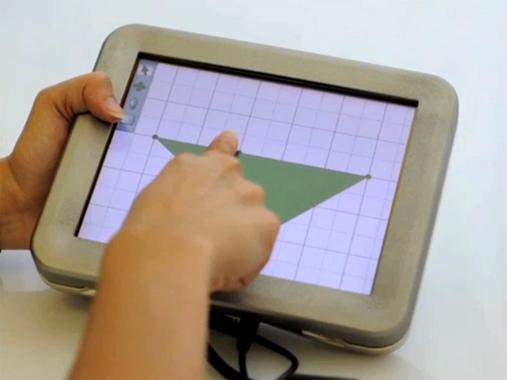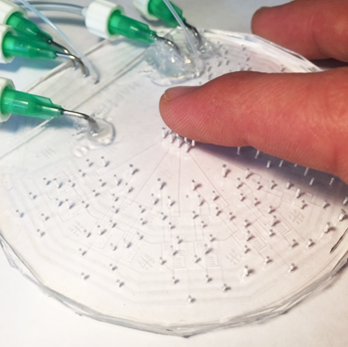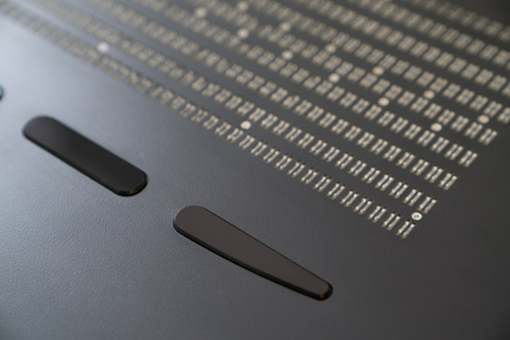CBI aims to be a hub for braille research and technology. As part of NBP, CBI's hope is to spread the word on the importance of braille and tactile literacy, while developing products to put it directly in the hands of the blind community.
- B2G White Paper
- B2G in the Context of Application Developers
- A Tactile Palette to Translate Graphics for the Visually Impaired
- Tactile Display for the Visually Impaired Using TeslaTouch
- Modeling Pneumatic Actuators for a Refreshable Tactile Display
- EAP Braille Display Needs and Requirements
- EAP actuators aid the quest for the "Holy Braille" of tactile displays
- Delivering navigational, situational, and educational information to the visually impaired via high-resolution moving tactile stimuli
- CBI White Paper
Tek Talk Interviews on AccessWorld
Blind Bargains Interviews
BrailleCast Interview
The world of technology is constantly evolving and demand increasing for digital information in real time. This includes digital standardized tests and textbooks for students and certification exams for adults. Unfortunately, for a blind student or adult, access to all of this information is not available in a practical digital format. Refreshable braille displays render only a single line of braille, which can be limiting for complex STEM (Science Technology Engineering Math) applications, as well as graphic diagrams and charts, which cannot be rendered in a real time digital output.
NBP's Center for Braille Innovation has been researching and partnering with research firms, universities and corporations to help solve this problem. Any successful solution must be capable of mass production at an affordable rate.
Some of our on current research projects are listed below. Also included are the partners with whom we are working.
Full page braille and graphic "Tablet for the Blind"
In 2011, NBP began doing research on developing a full page braille display. We demonstrated a 5 line braille display in July 2012. Shortly after, we realized we also need a way to create a full page tactile graphic output.
Since then, we have been working with a number of partners to solve this dilemma with different technology approaches.
 An electrostatic haptics method allows people to feel graphical images on a tablet with changes in friction that tricks the nerves on your finger to feel textures and lines that aren't really there. There are no moving parts with this technique. Senseg originally from Finland, Disney Research, Tanvas (a company with roots from Northwestern University) and EyeSyght in Australia are all working on products with similar methodologies.
An electrostatic haptics method allows people to feel graphical images on a tablet with changes in friction that tricks the nerves on your finger to feel textures and lines that aren't really there. There are no moving parts with this technique. Senseg originally from Finland, Disney Research, Tanvas (a company with roots from Northwestern University) and EyeSyght in Australia are all working on products with similar methodologies.
 New Haptics, a start-up company out of the University of Michigan has been working on an innovative pneumatic/microfluidic approach to raise braille and tactile graphic pins.
New Haptics, a start-up company out of the University of Michigan has been working on an innovative pneumatic/microfluidic approach to raise braille and tactile graphic pins.
- Polymer Braille is a company that is an offshoot of North Carolina State University that is looking at a method that would also create a braille and graphic tablet array.
- NBP is working with the Universal Accessibility Research Labs — UNARlabs (a new organization out of the University of Maine-Orono) to develop a software that can use an algorithm and machine learning to automate image classification and to develop rendering tools to convert this information into a tactile graphic for the blind.
 In March of 2019 NBP awarded the Touch of Genius Prize to two co-winners. Bristol Braille Technology from the UK won for the Canute, a low cost innovative design for a multi-line braille display (9 rows by 40 cells across). NBP is very interested in collaborating with Bristol Braille as a distributor and in research to support STEM applications.
ObjectiveEd won for the Braille Sheets, the design of braille and tactile overlays for a tablet that have audio support to help students learn braille and tactile literacy. NBP is also interested in exploring ways to help get this product to market to support braille literacy.
In March of 2019 NBP awarded the Touch of Genius Prize to two co-winners. Bristol Braille Technology from the UK won for the Canute, a low cost innovative design for a multi-line braille display (9 rows by 40 cells across). NBP is very interested in collaborating with Bristol Braille as a distributor and in research to support STEM applications.
ObjectiveEd won for the Braille Sheets, the design of braille and tactile overlays for a tablet that have audio support to help students learn braille and tactile literacy. NBP is also interested in exploring ways to help get this product to market to support braille literacy.
We continue to refresh our Research & Development page, so check back often.
